Machine learning fairness#
Machine Learning fairness is an important part of modern day data modeling. Here we explore an introduction to make models more fair and equitable.
Machine learning is a powerful tool that has revolutionized many industries by enabling computers to learn from data and make predictions or decisions.
However, as machine learning algorithms become increasingly ubiquitous in our daily lives, concerns about fairness and equity have emerged. Machine learning fairness refers to the idea that machine learning models should not perpetuate or exacerbate existing biases or discrimination. Fairness means that the model treats all individuals or groups fairly, regardless of race, gender, ethnicity, or other protected characteristics.
This notebook will provide an overview of the key concepts and challenges in machine learning fairness, as well as some techniques commonly used to address them.
How To#
from sklearn.model_selection import train_test_split
import pandas as pd
df = pd.read_csv("data/housing.csv").dropna()
df.head()
| longitude | latitude | housing_median_age | total_rooms | total_bedrooms | population | households | median_income | median_house_value | ocean_proximity | |
|---|---|---|---|---|---|---|---|---|---|---|
| 0 | -122.23 | 37.88 | 41.0 | 880.0 | 129.0 | 322.0 | 126.0 | 8.3252 | 452600.0 | NEAR BAY |
| 1 | -122.22 | 37.86 | 21.0 | 7099.0 | 1106.0 | 2401.0 | 1138.0 | 8.3014 | 358500.0 | NEAR BAY |
| 2 | -122.24 | 37.85 | 52.0 | 1467.0 | 190.0 | 496.0 | 177.0 | 7.2574 | 352100.0 | NEAR BAY |
| 3 | -122.25 | 37.85 | 52.0 | 1274.0 | 235.0 | 558.0 | 219.0 | 5.6431 | 341300.0 | NEAR BAY |
| 4 | -122.25 | 37.85 | 52.0 | 1627.0 | 280.0 | 565.0 | 259.0 | 3.8462 | 342200.0 | NEAR BAY |
x_train, x_, y_train, y_ = train_test_split(df.drop(["longitude","latitude", "ocean_proximity", "median_house_value"], axis=1),
df.median_house_value, test_size=.5, stratify=df.ocean_proximity)
x_val, x_test, y_val, y_test = train_test_split(x_, y_, test_size=.5)
from sklearn.ensemble import RandomForestRegressor
model = RandomForestRegressor().fit(x_train, y_train)
model.score(x_val, y_val)
0.6586735958677061
from sklearn.model_selection import cross_val_score
for cls in df.ocean_proximity.unique():
print(cls)
try:
idx = df[df.ocean_proximity.isin([cls])].index
idx_val = x_val.index.intersection(idx)
print(model.score(x_val.loc[idx_val, :], y_val.loc[idx_val]))
val = cross_val_score(model, x_val.loc[idx_val, :], y_val.loc[idx_val])
print(val)
print(val.mean(), " +- ", val.std(), "\n")
except:
print("Error in Validation")
try:
idx = df[df.ocean_proximity.isin([cls])].index
idx_test = x_test.index.intersection(idx)
print(model.score(x_test.loc[idx_test, :], y_test.loc[idx_test]))
tst = cross_val_score(model,x_test.loc[idx_test, :], y_test.loc[idx_test])
print(tst)
print(tst.mean(), " +- ", tst.std(), "\n")
except:
print("Error in Test")
NEAR BAY
0.6914888806800314
[0.51361569 0.64630664 0.59280962 0.69167432 0.66258008]
0.621397271310316 +- 0.06275266873707354
0.5750599987255491
[0.46930571 0.43675151 0.56149112 0.53991517 0.43855913]
0.4892045308559778 +- 0.05197914753138655
<1H OCEAN
0.6164340776775521
[0.62935218 0.58064886 0.57057219 0.62693846 0.66328712]
0.6141597616245293 +- 0.034148086465257306
0.6191524643956172
[0.62363128 0.61138027 0.60811331 0.57578551 0.60926118]
0.6056343121336554 +- 0.015919533470271377
INLAND
0.1967543190323986
[0.60097059 0.43543378 0.47527694 0.48630933 0.57854818]
0.5153077647383298 +- 0.06349913017713156
0.20640897263306657
[0.47371532 0.54227822 0.23409711 0.52081891 0.43949161]
0.4420802336257415 +- 0.1100035220041293
NEAR OCEAN
0.5441817718762696
[0.56994925 0.62178888 0.52010515 0.50148382 0.57472886]
0.5576111924627768 +- 0.042710663438220095
0.6036955726079807
[0.5883007 0.61904115 0.55511549 0.49335263 0.55245425]
0.5616528456131616 +- 0.04194233268167542
ISLAND
-4.747812762984071
Error in Validation
nan
Error in Test
Calculate Residuals#
from yellowbrick.regressor import residuals_plot, prediction_error
residuals_plot(model, x_train, y_train, x_test, y_test)
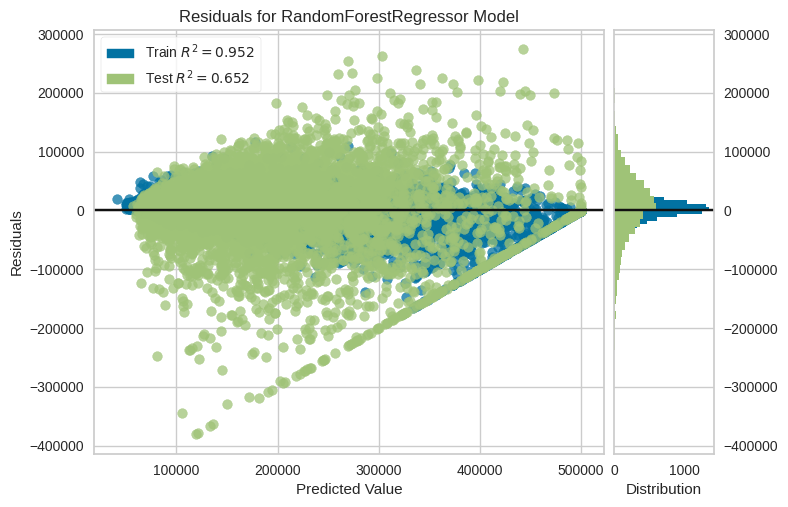
---------------------------------------------------------------------------
AttributeError Traceback (most recent call last)
File /opt/hostedtoolcache/Python/3.8.18/x64/lib/python3.8/site-packages/yellowbrick/utils/wrapper.py:48, in Wrapper.__getattr__(self, attr)
47 try:
---> 48 return getattr(self._wrapped, attr)
49 except AttributeError as e:
AttributeError: 'RandomForestRegressor' object has no attribute 'line_color'
The above exception was the direct cause of the following exception:
YellowbrickAttributeError Traceback (most recent call last)
File /opt/hostedtoolcache/Python/3.8.18/x64/lib/python3.8/site-packages/IPython/core/formatters.py:974, in MimeBundleFormatter.__call__(self, obj, include, exclude)
971 method = get_real_method(obj, self.print_method)
973 if method is not None:
--> 974 return method(include=include, exclude=exclude)
975 return None
976 else:
File /opt/hostedtoolcache/Python/3.8.18/x64/lib/python3.8/site-packages/sklearn/base.py:669, in BaseEstimator._repr_mimebundle_(self, **kwargs)
667 def _repr_mimebundle_(self, **kwargs):
668 """Mime bundle used by jupyter kernels to display estimator"""
--> 669 output = {"text/plain": repr(self)}
670 if get_config()["display"] == "diagram":
671 output["text/html"] = estimator_html_repr(self)
File /opt/hostedtoolcache/Python/3.8.18/x64/lib/python3.8/site-packages/sklearn/base.py:287, in BaseEstimator.__repr__(self, N_CHAR_MAX)
279 # use ellipsis for sequences with a lot of elements
280 pp = _EstimatorPrettyPrinter(
281 compact=True,
282 indent=1,
283 indent_at_name=True,
284 n_max_elements_to_show=N_MAX_ELEMENTS_TO_SHOW,
285 )
--> 287 repr_ = pp.pformat(self)
289 # Use bruteforce ellipsis when there are a lot of non-blank characters
290 n_nonblank = len("".join(repr_.split()))
File /opt/hostedtoolcache/Python/3.8.18/x64/lib/python3.8/pprint.py:153, in PrettyPrinter.pformat(self, object)
151 def pformat(self, object):
152 sio = _StringIO()
--> 153 self._format(object, sio, 0, 0, {}, 0)
154 return sio.getvalue()
File /opt/hostedtoolcache/Python/3.8.18/x64/lib/python3.8/pprint.py:170, in PrettyPrinter._format(self, object, stream, indent, allowance, context, level)
168 self._readable = False
169 return
--> 170 rep = self._repr(object, context, level)
171 max_width = self._width - indent - allowance
172 if len(rep) > max_width:
File /opt/hostedtoolcache/Python/3.8.18/x64/lib/python3.8/pprint.py:404, in PrettyPrinter._repr(self, object, context, level)
403 def _repr(self, object, context, level):
--> 404 repr, readable, recursive = self.format(object, context.copy(),
405 self._depth, level)
406 if not readable:
407 self._readable = False
File /opt/hostedtoolcache/Python/3.8.18/x64/lib/python3.8/site-packages/sklearn/utils/_pprint.py:189, in _EstimatorPrettyPrinter.format(self, object, context, maxlevels, level)
188 def format(self, object, context, maxlevels, level):
--> 189 return _safe_repr(
190 object, context, maxlevels, level, changed_only=self._changed_only
191 )
File /opt/hostedtoolcache/Python/3.8.18/x64/lib/python3.8/site-packages/sklearn/utils/_pprint.py:440, in _safe_repr(object, context, maxlevels, level, changed_only)
438 recursive = False
439 if changed_only:
--> 440 params = _changed_params(object)
441 else:
442 params = object.get_params(deep=False)
File /opt/hostedtoolcache/Python/3.8.18/x64/lib/python3.8/site-packages/sklearn/utils/_pprint.py:93, in _changed_params(estimator)
89 def _changed_params(estimator):
90 """Return dict (param_name: value) of parameters that were given to
91 estimator with non-default values."""
---> 93 params = estimator.get_params(deep=False)
94 init_func = getattr(estimator.__init__, "deprecated_original", estimator.__init__)
95 init_params = inspect.signature(init_func).parameters
File /opt/hostedtoolcache/Python/3.8.18/x64/lib/python3.8/site-packages/yellowbrick/base.py:342, in ModelVisualizer.get_params(self, deep)
334 def get_params(self, deep=True):
335 """
336 After v0.24 - scikit-learn is able to determine that ``self.estimator`` is
337 nested and fetches its params using ``estimator__param``. This functionality is
(...)
340 the estimator params.
341 """
--> 342 params = super(ModelVisualizer, self).get_params(deep=deep)
343 for param in list(params.keys()):
344 if param.startswith("estimator__"):
File /opt/hostedtoolcache/Python/3.8.18/x64/lib/python3.8/site-packages/sklearn/base.py:195, in BaseEstimator.get_params(self, deep)
193 out = dict()
194 for key in self._get_param_names():
--> 195 value = getattr(self, key)
196 if deep and hasattr(value, "get_params") and not isinstance(value, type):
197 deep_items = value.get_params().items()
File /opt/hostedtoolcache/Python/3.8.18/x64/lib/python3.8/site-packages/yellowbrick/utils/wrapper.py:50, in Wrapper.__getattr__(self, attr)
48 return getattr(self._wrapped, attr)
49 except AttributeError as e:
---> 50 raise YellowbrickAttributeError(f"neither visualizer '{self.__class__.__name__}' nor wrapped estimator '{type(self._wrapped).__name__}' have attribute '{attr}'") from e
YellowbrickAttributeError: neither visualizer 'ResidualsPlot' nor wrapped estimator 'RandomForestRegressor' have attribute 'line_color'
---------------------------------------------------------------------------
AttributeError Traceback (most recent call last)
File /opt/hostedtoolcache/Python/3.8.18/x64/lib/python3.8/site-packages/yellowbrick/utils/wrapper.py:48, in Wrapper.__getattr__(self, attr)
47 try:
---> 48 return getattr(self._wrapped, attr)
49 except AttributeError as e:
AttributeError: 'RandomForestRegressor' object has no attribute 'line_color'
The above exception was the direct cause of the following exception:
YellowbrickAttributeError Traceback (most recent call last)
File /opt/hostedtoolcache/Python/3.8.18/x64/lib/python3.8/site-packages/IPython/core/formatters.py:708, in PlainTextFormatter.__call__(self, obj)
701 stream = StringIO()
702 printer = pretty.RepresentationPrinter(stream, self.verbose,
703 self.max_width, self.newline,
704 max_seq_length=self.max_seq_length,
705 singleton_pprinters=self.singleton_printers,
706 type_pprinters=self.type_printers,
707 deferred_pprinters=self.deferred_printers)
--> 708 printer.pretty(obj)
709 printer.flush()
710 return stream.getvalue()
File /opt/hostedtoolcache/Python/3.8.18/x64/lib/python3.8/site-packages/IPython/lib/pretty.py:410, in RepresentationPrinter.pretty(self, obj)
407 return meth(obj, self, cycle)
408 if cls is not object \
409 and callable(cls.__dict__.get('__repr__')):
--> 410 return _repr_pprint(obj, self, cycle)
412 return _default_pprint(obj, self, cycle)
413 finally:
File /opt/hostedtoolcache/Python/3.8.18/x64/lib/python3.8/site-packages/IPython/lib/pretty.py:778, in _repr_pprint(obj, p, cycle)
776 """A pprint that just redirects to the normal repr function."""
777 # Find newlines and replace them with p.break_()
--> 778 output = repr(obj)
779 lines = output.splitlines()
780 with p.group():
File /opt/hostedtoolcache/Python/3.8.18/x64/lib/python3.8/site-packages/sklearn/base.py:287, in BaseEstimator.__repr__(self, N_CHAR_MAX)
279 # use ellipsis for sequences with a lot of elements
280 pp = _EstimatorPrettyPrinter(
281 compact=True,
282 indent=1,
283 indent_at_name=True,
284 n_max_elements_to_show=N_MAX_ELEMENTS_TO_SHOW,
285 )
--> 287 repr_ = pp.pformat(self)
289 # Use bruteforce ellipsis when there are a lot of non-blank characters
290 n_nonblank = len("".join(repr_.split()))
File /opt/hostedtoolcache/Python/3.8.18/x64/lib/python3.8/pprint.py:153, in PrettyPrinter.pformat(self, object)
151 def pformat(self, object):
152 sio = _StringIO()
--> 153 self._format(object, sio, 0, 0, {}, 0)
154 return sio.getvalue()
File /opt/hostedtoolcache/Python/3.8.18/x64/lib/python3.8/pprint.py:170, in PrettyPrinter._format(self, object, stream, indent, allowance, context, level)
168 self._readable = False
169 return
--> 170 rep = self._repr(object, context, level)
171 max_width = self._width - indent - allowance
172 if len(rep) > max_width:
File /opt/hostedtoolcache/Python/3.8.18/x64/lib/python3.8/pprint.py:404, in PrettyPrinter._repr(self, object, context, level)
403 def _repr(self, object, context, level):
--> 404 repr, readable, recursive = self.format(object, context.copy(),
405 self._depth, level)
406 if not readable:
407 self._readable = False
File /opt/hostedtoolcache/Python/3.8.18/x64/lib/python3.8/site-packages/sklearn/utils/_pprint.py:189, in _EstimatorPrettyPrinter.format(self, object, context, maxlevels, level)
188 def format(self, object, context, maxlevels, level):
--> 189 return _safe_repr(
190 object, context, maxlevels, level, changed_only=self._changed_only
191 )
File /opt/hostedtoolcache/Python/3.8.18/x64/lib/python3.8/site-packages/sklearn/utils/_pprint.py:440, in _safe_repr(object, context, maxlevels, level, changed_only)
438 recursive = False
439 if changed_only:
--> 440 params = _changed_params(object)
441 else:
442 params = object.get_params(deep=False)
File /opt/hostedtoolcache/Python/3.8.18/x64/lib/python3.8/site-packages/sklearn/utils/_pprint.py:93, in _changed_params(estimator)
89 def _changed_params(estimator):
90 """Return dict (param_name: value) of parameters that were given to
91 estimator with non-default values."""
---> 93 params = estimator.get_params(deep=False)
94 init_func = getattr(estimator.__init__, "deprecated_original", estimator.__init__)
95 init_params = inspect.signature(init_func).parameters
File /opt/hostedtoolcache/Python/3.8.18/x64/lib/python3.8/site-packages/yellowbrick/base.py:342, in ModelVisualizer.get_params(self, deep)
334 def get_params(self, deep=True):
335 """
336 After v0.24 - scikit-learn is able to determine that ``self.estimator`` is
337 nested and fetches its params using ``estimator__param``. This functionality is
(...)
340 the estimator params.
341 """
--> 342 params = super(ModelVisualizer, self).get_params(deep=deep)
343 for param in list(params.keys()):
344 if param.startswith("estimator__"):
File /opt/hostedtoolcache/Python/3.8.18/x64/lib/python3.8/site-packages/sklearn/base.py:195, in BaseEstimator.get_params(self, deep)
193 out = dict()
194 for key in self._get_param_names():
--> 195 value = getattr(self, key)
196 if deep and hasattr(value, "get_params") and not isinstance(value, type):
197 deep_items = value.get_params().items()
File /opt/hostedtoolcache/Python/3.8.18/x64/lib/python3.8/site-packages/yellowbrick/utils/wrapper.py:50, in Wrapper.__getattr__(self, attr)
48 return getattr(self._wrapped, attr)
49 except AttributeError as e:
---> 50 raise YellowbrickAttributeError(f"neither visualizer '{self.__class__.__name__}' nor wrapped estimator '{type(self._wrapped).__name__}' have attribute '{attr}'") from e
YellowbrickAttributeError: neither visualizer 'ResidualsPlot' nor wrapped estimator 'RandomForestRegressor' have attribute 'line_color'
---------------------------------------------------------------------------
AttributeError Traceback (most recent call last)
File /opt/hostedtoolcache/Python/3.8.18/x64/lib/python3.8/site-packages/yellowbrick/utils/wrapper.py:48, in Wrapper.__getattr__(self, attr)
47 try:
---> 48 return getattr(self._wrapped, attr)
49 except AttributeError as e:
AttributeError: 'RandomForestRegressor' object has no attribute 'line_color'
The above exception was the direct cause of the following exception:
YellowbrickAttributeError Traceback (most recent call last)
File /opt/hostedtoolcache/Python/3.8.18/x64/lib/python3.8/site-packages/IPython/core/formatters.py:344, in BaseFormatter.__call__(self, obj)
342 method = get_real_method(obj, self.print_method)
343 if method is not None:
--> 344 return method()
345 return None
346 else:
File /opt/hostedtoolcache/Python/3.8.18/x64/lib/python3.8/site-packages/sklearn/base.py:665, in BaseEstimator._repr_html_inner(self)
660 def _repr_html_inner(self):
661 """This function is returned by the @property `_repr_html_` to make
662 `hasattr(estimator, "_repr_html_") return `True` or `False` depending
663 on `get_config()["display"]`.
664 """
--> 665 return estimator_html_repr(self)
File /opt/hostedtoolcache/Python/3.8.18/x64/lib/python3.8/site-packages/sklearn/utils/_estimator_html_repr.py:388, in estimator_html_repr(estimator)
386 style_template = Template(_STYLE)
387 style_with_id = style_template.substitute(id=container_id)
--> 388 estimator_str = str(estimator)
390 # The fallback message is shown by default and loading the CSS sets
391 # div.sk-text-repr-fallback to display: none to hide the fallback message.
392 #
(...)
397 # The reverse logic applies to HTML repr div.sk-container.
398 # div.sk-container is hidden by default and the loading the CSS displays it.
399 fallback_msg = (
400 "In a Jupyter environment, please rerun this cell to show the HTML"
401 " representation or trust the notebook. <br />On GitHub, the"
402 " HTML representation is unable to render, please try loading this page"
403 " with nbviewer.org."
404 )
File /opt/hostedtoolcache/Python/3.8.18/x64/lib/python3.8/site-packages/sklearn/base.py:287, in BaseEstimator.__repr__(self, N_CHAR_MAX)
279 # use ellipsis for sequences with a lot of elements
280 pp = _EstimatorPrettyPrinter(
281 compact=True,
282 indent=1,
283 indent_at_name=True,
284 n_max_elements_to_show=N_MAX_ELEMENTS_TO_SHOW,
285 )
--> 287 repr_ = pp.pformat(self)
289 # Use bruteforce ellipsis when there are a lot of non-blank characters
290 n_nonblank = len("".join(repr_.split()))
File /opt/hostedtoolcache/Python/3.8.18/x64/lib/python3.8/pprint.py:153, in PrettyPrinter.pformat(self, object)
151 def pformat(self, object):
152 sio = _StringIO()
--> 153 self._format(object, sio, 0, 0, {}, 0)
154 return sio.getvalue()
File /opt/hostedtoolcache/Python/3.8.18/x64/lib/python3.8/pprint.py:170, in PrettyPrinter._format(self, object, stream, indent, allowance, context, level)
168 self._readable = False
169 return
--> 170 rep = self._repr(object, context, level)
171 max_width = self._width - indent - allowance
172 if len(rep) > max_width:
File /opt/hostedtoolcache/Python/3.8.18/x64/lib/python3.8/pprint.py:404, in PrettyPrinter._repr(self, object, context, level)
403 def _repr(self, object, context, level):
--> 404 repr, readable, recursive = self.format(object, context.copy(),
405 self._depth, level)
406 if not readable:
407 self._readable = False
File /opt/hostedtoolcache/Python/3.8.18/x64/lib/python3.8/site-packages/sklearn/utils/_pprint.py:189, in _EstimatorPrettyPrinter.format(self, object, context, maxlevels, level)
188 def format(self, object, context, maxlevels, level):
--> 189 return _safe_repr(
190 object, context, maxlevels, level, changed_only=self._changed_only
191 )
File /opt/hostedtoolcache/Python/3.8.18/x64/lib/python3.8/site-packages/sklearn/utils/_pprint.py:440, in _safe_repr(object, context, maxlevels, level, changed_only)
438 recursive = False
439 if changed_only:
--> 440 params = _changed_params(object)
441 else:
442 params = object.get_params(deep=False)
File /opt/hostedtoolcache/Python/3.8.18/x64/lib/python3.8/site-packages/sklearn/utils/_pprint.py:93, in _changed_params(estimator)
89 def _changed_params(estimator):
90 """Return dict (param_name: value) of parameters that were given to
91 estimator with non-default values."""
---> 93 params = estimator.get_params(deep=False)
94 init_func = getattr(estimator.__init__, "deprecated_original", estimator.__init__)
95 init_params = inspect.signature(init_func).parameters
File /opt/hostedtoolcache/Python/3.8.18/x64/lib/python3.8/site-packages/yellowbrick/base.py:342, in ModelVisualizer.get_params(self, deep)
334 def get_params(self, deep=True):
335 """
336 After v0.24 - scikit-learn is able to determine that ``self.estimator`` is
337 nested and fetches its params using ``estimator__param``. This functionality is
(...)
340 the estimator params.
341 """
--> 342 params = super(ModelVisualizer, self).get_params(deep=deep)
343 for param in list(params.keys()):
344 if param.startswith("estimator__"):
File /opt/hostedtoolcache/Python/3.8.18/x64/lib/python3.8/site-packages/sklearn/base.py:195, in BaseEstimator.get_params(self, deep)
193 out = dict()
194 for key in self._get_param_names():
--> 195 value = getattr(self, key)
196 if deep and hasattr(value, "get_params") and not isinstance(value, type):
197 deep_items = value.get_params().items()
File /opt/hostedtoolcache/Python/3.8.18/x64/lib/python3.8/site-packages/yellowbrick/utils/wrapper.py:50, in Wrapper.__getattr__(self, attr)
48 return getattr(self._wrapped, attr)
49 except AttributeError as e:
---> 50 raise YellowbrickAttributeError(f"neither visualizer '{self.__class__.__name__}' nor wrapped estimator '{type(self._wrapped).__name__}' have attribute '{attr}'") from e
YellowbrickAttributeError: neither visualizer 'ResidualsPlot' nor wrapped estimator 'RandomForestRegressor' have attribute 'line_color'
prediction_error(model, x_train, y_train, x_test, y_test)
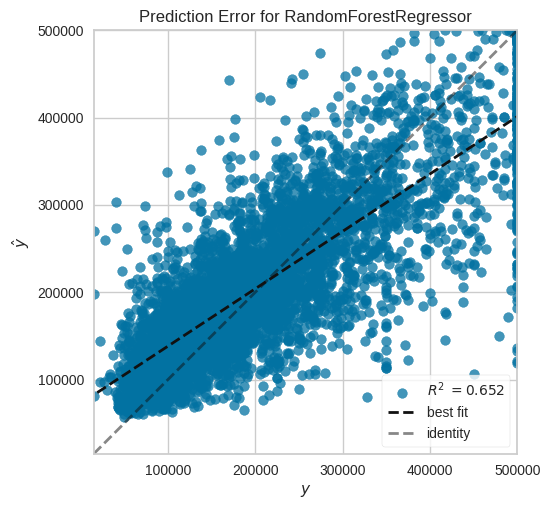
PredictionError(ax=<Axes: title={'center': 'Prediction Error for RandomForestRegressor'}, xlabel='$y$', ylabel='$\\hat{y}$'>,
estimator=RandomForestRegressor())In a Jupyter environment, please rerun this cell to show the HTML representation or trust the notebook. On GitHub, the HTML representation is unable to render, please try loading this page with nbviewer.org.
PredictionError(ax=<Axes: title={'center': 'Prediction Error for RandomForestRegressor'}, xlabel='$y$', ylabel='$\\hat{y}$'>,
estimator=RandomForestRegressor())RandomForestRegressor()
RandomForestRegressor()
Confusion Matrix for Classifiers#
from sklearn.metrics import plot_confusion_matrix
---------------------------------------------------------------------------
ImportError Traceback (most recent call last)
Cell In[10], line 1
----> 1 from sklearn.metrics import plot_confusion_matrix
ImportError: cannot import name 'plot_confusion_matrix' from 'sklearn.metrics' (/opt/hostedtoolcache/Python/3.8.18/x64/lib/python3.8/site-packages/sklearn/metrics/__init__.py)
from sklearn.ensemble import RandomForestClassifier
x_train, x_, y_train, y_ = train_test_split(df.drop(["longitude","latitude", "ocean_proximity"], axis=1),
df.ocean_proximity, test_size=.5, stratify=df.ocean_proximity)
x_val, x_test, y_val, y_test = train_test_split(x_, y_, test_size=.5)
model = RandomForestClassifier().fit(x_train, y_train)
plot_confusion_matrix(model, x_test, y_test)
---------------------------------------------------------------------------
NameError Traceback (most recent call last)
Cell In[12], line 1
----> 1 plot_confusion_matrix(model, x_test, y_test)
NameError: name 'plot_confusion_matrix' is not defined
plot_confusion_matrix(model, x_test, y_test, normalize="all")
---------------------------------------------------------------------------
NameError Traceback (most recent call last)
Cell In[13], line 1
----> 1 plot_confusion_matrix(model, x_test, y_test, normalize="all")
NameError: name 'plot_confusion_matrix' is not defined
Other Visualizations that are important#
from yellowbrick.classifier import confusion_matrix, classification_report, precision_recall_curve, roc_auc
confusion_matrix(model, x_train, y_train, x_test, y_test)
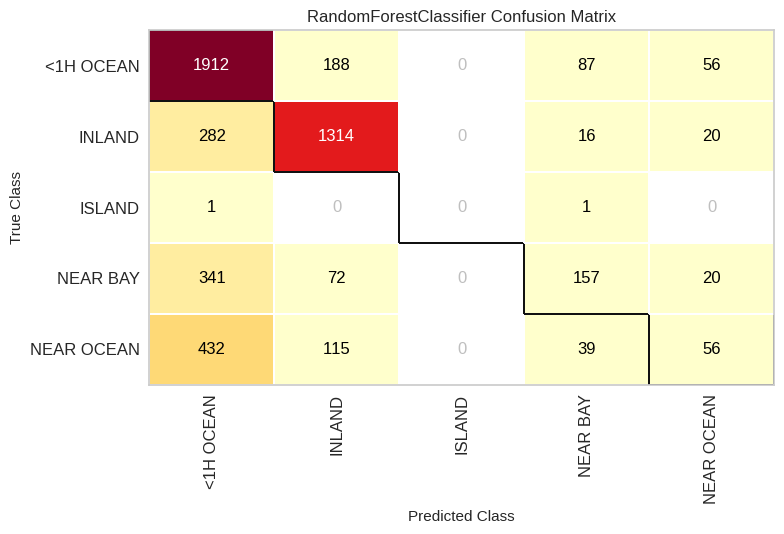
ConfusionMatrix(ax=<Axes: title={'center': 'RandomForestClassifier Confusion Matrix'}, xlabel='Predicted Class', ylabel='True Class'>,
cmap=<matplotlib.colors.ListedColormap object at 0x7fa324633b50>,
estimator=RandomForestClassifier())In a Jupyter environment, please rerun this cell to show the HTML representation or trust the notebook. On GitHub, the HTML representation is unable to render, please try loading this page with nbviewer.org.
ConfusionMatrix(ax=<Axes: title={'center': 'RandomForestClassifier Confusion Matrix'}, xlabel='Predicted Class', ylabel='True Class'>,
cmap=<matplotlib.colors.ListedColormap object at 0x7fa324633b50>,
estimator=RandomForestClassifier())RandomForestClassifier()
RandomForestClassifier()
classification_report(model, x_train, y_train, x_test, y_test)
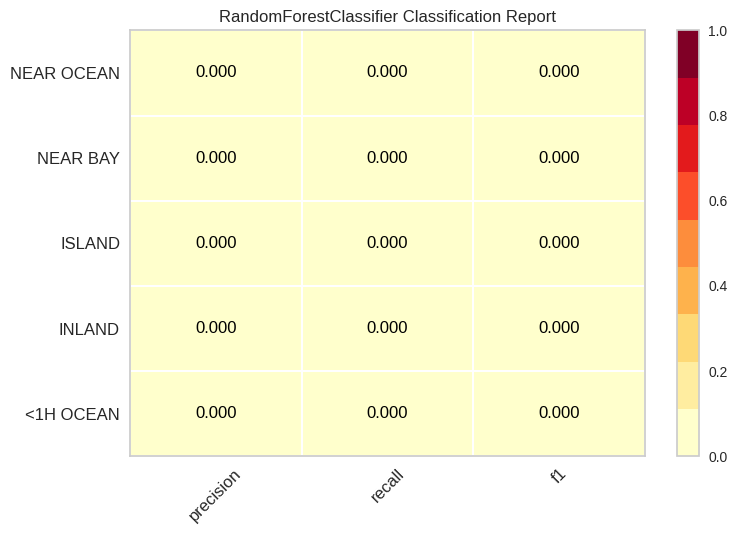
ClassificationReport(ax=<Axes: title={'center': 'RandomForestClassifier Classification Report'}>,
cmap=<matplotlib.colors.ListedColormap object at 0x7fa324481190>,
estimator=RandomForestClassifier())In a Jupyter environment, please rerun this cell to show the HTML representation or trust the notebook. On GitHub, the HTML representation is unable to render, please try loading this page with nbviewer.org.
ClassificationReport(ax=<Axes: title={'center': 'RandomForestClassifier Classification Report'}>,
cmap=<matplotlib.colors.ListedColormap object at 0x7fa324481190>,
estimator=RandomForestClassifier())RandomForestClassifier()
RandomForestClassifier()
from sklearn.metrics import classification_report
print(classification_report(y_test, model.predict(x_test)))
precision recall f1-score support
<1H OCEAN 0.64 0.85 0.73 2243
INLAND 0.78 0.81 0.79 1632
ISLAND 0.00 0.00 0.00 2
NEAR BAY 0.52 0.27 0.35 590
NEAR OCEAN 0.37 0.09 0.14 642
accuracy 0.67 5109
macro avg 0.46 0.40 0.40 5109
weighted avg 0.64 0.67 0.63 5109
precision_recall_curve(model, x_train, y_train, x_test, y_test)
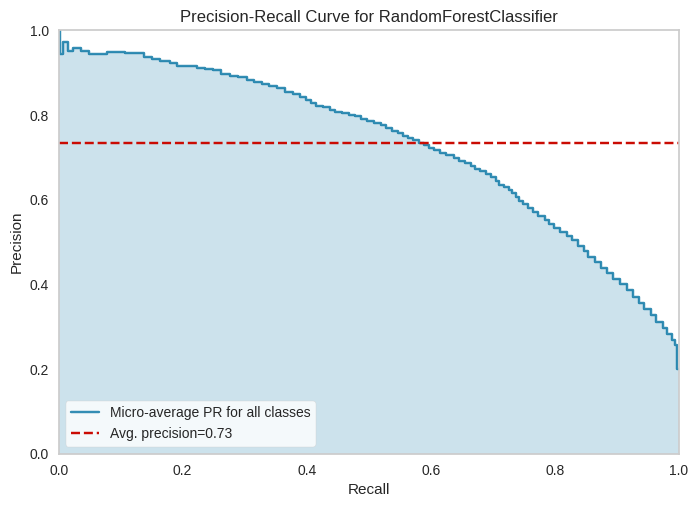
PrecisionRecallCurve(ax=<Axes: title={'center': 'Precision-Recall Curve for RandomForestClassifier'}, xlabel='Recall', ylabel='Precision'>,
estimator=OneVsRestClassifier(estimator=RandomForestClassifier()),
iso_f1_values={0.2, 0.4, 0.6, 0.8})In a Jupyter environment, please rerun this cell to show the HTML representation or trust the notebook. On GitHub, the HTML representation is unable to render, please try loading this page with nbviewer.org.
PrecisionRecallCurve(ax=<Axes: title={'center': 'Precision-Recall Curve for RandomForestClassifier'}, xlabel='Recall', ylabel='Precision'>,
estimator=OneVsRestClassifier(estimator=RandomForestClassifier()),
iso_f1_values={0.2, 0.4, 0.6, 0.8})OneVsRestClassifier(estimator=RandomForestClassifier())
RandomForestClassifier()
RandomForestClassifier()
roc_auc(model, x_train, y_train, x_test, y_test)
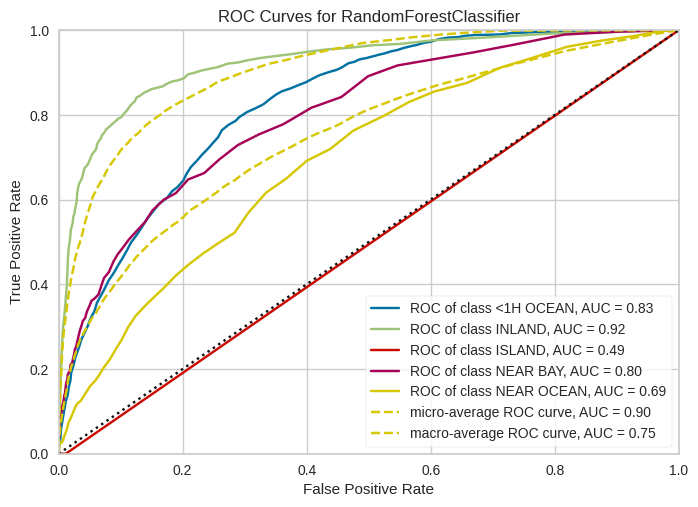
ROCAUC(ax=<Axes: title={'center': 'ROC Curves for RandomForestClassifier'}, xlabel='False Positive Rate', ylabel='True Positive Rate'>,
estimator=RandomForestClassifier())In a Jupyter environment, please rerun this cell to show the HTML representation or trust the notebook. On GitHub, the HTML representation is unable to render, please try loading this page with nbviewer.org.
ROCAUC(ax=<Axes: title={'center': 'ROC Curves for RandomForestClassifier'}, xlabel='False Positive Rate', ylabel='True Positive Rate'>,
estimator=RandomForestClassifier())RandomForestClassifier()
RandomForestClassifier()
Exercise#
Modify the code to generate dummy models for each class.


